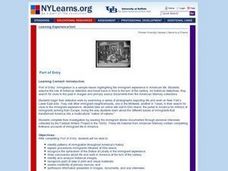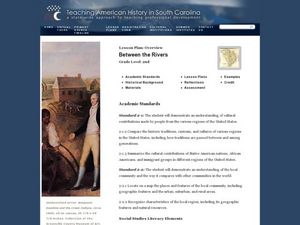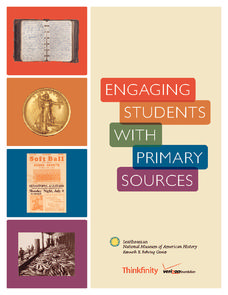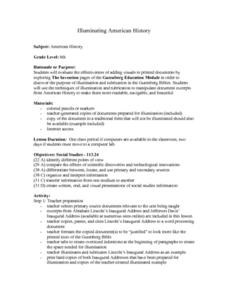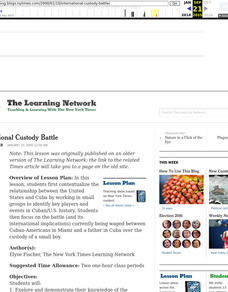Smithsonian Institution
Mary Henry: Journal/Diary Writing
A great way to connect social studies with language arts, a resource on Mary Henry's historical diary reinforces the concepts of primary and secondary sources. It comes with an easy-to-understand lesson plan, as well as the reference...
Channel Islands Film
Once Upon A Time (Saxipak’a): Lesson Plan 1
As part of a study of the history of the Chumash on California's Channel Island chain, class members view the documentary Once Upon a Time, respond to discussion questions, and create a timeline for the different waves of migration.
US National Archives
WWII: Western Europe 1939-45 – Deception and Bluff
World War II left the British desperate for help in any form—including in the form of a magician! High schooler conduct research on Jasper Maskelyne, a stage magician who used his talents to deceive the Germans on the war front, before...
Curated OER
Rationalizing Race in US History
Students consider the classification of people. In this race studies lesson, students examine the concept of race as it relates to U.S. history and trends. Students research racial discrimination and prejudice in order to support their...
Curated OER
Port of Entry
Students research patterns of immigration throughout American history. The focus is on the process of how immigrants came through Ellis Island. Students reflect upon the topic to develop critical thinking skills.
Curated OER
Ladies, Contraband, and Spies: Women in the Civil War
Students use primary sources - diaries, letters, and photographs - to explore the experiences of women in the Civil War. By looking at a series of document galleries, the perspectives of slave women, plantation mistresses, female spies,...
Incredible Art Department
Story Tellers - "Passing on the Traditions"
It's important for young people to learn about their ancestry and the role of storytelling as a means of passing along traditions, information, and lessons. Based on what they already learned about Native American oral tradition,...
Curated OER
Between the Rivers
Second graders compare and contrast historical American cultures. In this American history lesson, 2nd graders participate in reading, writing, oral, and hands on activities. Students discuss the similarities and differences between...
Curated OER
Tracing the Route of Bracero
Students make a map showing the work of a Bracero Worker. In this Bracero lesson plan, students listen to a worker in an online oral history as he explains his work locations and crops. They use a map to plot the areas he worked and the...
Curated OER
A to Z Observations
Eighth graders examine the cultural conflicts that occurred when Europeans moved into the land the Native Americans lived on that would become West Virginia. In this West Virginia history lesson, 8th graders visit the state history...
Curated OER
Memories of School Days
Students interview, record, and retell school stories of a family member. They research, document, and describe how schools have changed over time.
Smithsonian Institution
Engaging Students with Primary Source
Young historians learn how to analyze various forms of primary source documents. The colorful packet is packed with all you need to engage kids in this essential skill.
Curated OER
IB History of the Americas Historiography: Limits of the Historical Record
In this historical record worksheet, students read about analyzing primary sources and then complete the 3 listed activities to create their own historical accounts.
Curated OER
Illuminating American History
Eighth graders evaluate the effectiveness of adding visuals to printed documents by exploring "The Invention" pages of the "Gutenberg Education Module". They use the techniques of illumination and rubrication to manipulate documents from...
Curated OER
Could You Make an Oak Basket?
Students listen to an interview with Lucreaty Clark, a White Oak Native American basket maker. They analyze the interview and record their observations on a worksheet. Students consider information that can be gleaned from an audio...
Center for History and New Media
Growing Up in a Segregated Society, 1880s–1930s
What did segregation look like in the beginning of the 20th century? Middle and high schoolers view images of segregated areas, read passages by Booker T. Washington and W.E.B. DuBois, and come to conclusions about how the influence of...
Curated OER
A Visit to Aunt Louisa's
Fourth graders write a diary entry. In this journaling instructional activity students examine a 1880's primary source document. Students read about a young girl visiting her Aunt in rural Indiana. Students write about what they did in...
Curated OER
International Custody Battle
Students research the relationship between the United States and Cuba by identifying key players and events in Cuban/U.S. history. They also focus on a battle waged between Cuban-Americans in Miami and a father in Cuba over the custody...
Curated OER
New York City Delights: The Taxi Cab
You set the rate! Step into the shoes of a taxi driver in New York City, and also pretend to be a person who uses taxis to get around town. The class will conduct collaborative research to learn about the history of taxis. Then, they...
Cleveland Museum of Art
Japanese Folktales (Asian Odyssey)
The Cleveland Museum of Art presents this interdisciplinary model unit that asks class members to explore how the same themes are presented in the folktales and art of several cultures.
Mary Pope Osborne, Classroom Adventures Program
The Backpack Travel Journals
Strap on those backpacks, it's time to travel through history with this literature unit based on the first four books of The Magic Tree House series. While reading through these fun stories, children create story maps, record interesting...
US Environmental Protection Agency
Water, Now and Then
Students describe, orally or in writing, ways people have depended on water during different periods of history. This nearly 500 page document is rich with diverse lessons and activities that will transform your young learners into water...
Curated OER
Tracing the History Of Food
Students explore cultural variations in food preparation. They pick a country and research dishes of cultural significance. They prepare their food and present the dish to the class creatively.
Curated OER
The History of the Holocaust From A Personal Perspective
Young scholars research and identify how Holocaust events affected lives of real people who lived in Europe from 1933 through 1945 and after, and create original artwork, poetry, and essays that reflect understanding of Holocaust, and...






